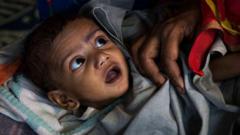The stunting epidemic impacting over 35% of children under five in India reveals a troubling link to social identity, particularly caste. Despite improvements in health, children from marginalized groups face disproportionately higher risks of malnutrition, challenging the prevailing narrative of genetic and environmental causes.
Unpacking Child Stunting in India: The Role of Caste and Social Disparities

Unpacking Child Stunting in India: The Role of Caste and Social Disparities
A recent study reveals that India's child stunting crisis is deeply intertwined with caste discrimination, with alarming rates that surpass those in Sub-Saharan Africa.
India continues to grapple with a staggering child stunting crisis, where over 35% of its 137 million children under five are affected, according to official data. Recent research from Ashoka University and Monash University highlights that the roots of this situation go deeper than nutritional deficiencies; longstanding caste discrimination is proving to be a significant contributor.
While both India and Sub-Saharan Africa account for over 70% of the world's stunted children, India's rate of 35.7% slightly surpasses the 33.6% average in Sub-Saharan Africa. Stunting, defined by a child’s height being below the expected for their age, indicates critical gaps in nutrition and health during early development — the “golden period” from conception to the first two years of life is crucial for brain growth and overall future potential.
The study emphasizes that earlier comparisons of height discrepancies between Indian and Sub-Saharan African children have primarily focused on physical measurements, often neglecting the influence of caste and social identity. By examining factors beyond nutrition, researchers discovered stark differences in stunting rates according to caste hierarchy. Higher-ranked, non-stigmatized caste groups registered stunting rates of only 27%, compared to much higher rates among marginalised groups such as adivasis and Dalits.
Despite attempts to mitigate this issue through affirmative action over the last 70 years, India's caste system remains deeply embedded, showcasing significant disparities in access to nutrition and healthcare. The data reveals that children from marginalized backgrounds face a staggering risk of malnutrition due to various socio-economic factors.
Contributing to this debate, some argue that genetic predispositions account for lower heights among Indian children, while others suggest that generational improvements in nutrition have mitigated these discrepancies over time. However, what remains clear is that socioeconomic disadvantages greatly impact health outcomes. Well-educated mothers and more affluent families experience drastically lower stunting rates compared to those from poorer backgrounds or with less education.
Despite these challenges, a 2022 study highlighted a reduction in stunting among various social groups in India, signaling that targeted health and nutrition interventions can bear positive results. Since 2010, there's been a decline in stunting rates across Sub-Saharan Africa, though absolute numbers of stunted children continue to rise in certain contexts.
The nuanced findings in this research advocate for a broader understanding of child malnutrition that includes caste identity as a critical factor. Detailed analyses leverage data from demographic and health surveys conducted from 2019-2021 in India, and comparable data from Sub-Saharan Africa, revealing stark contrasts in the health and nutrition landscape faced by vulnerable populations.
By acknowledging the significant role of social identity within the discourse around child stunting, stakeholders can effectively tailor interventions aimed at addressing the root causes of malnutrition in India, ultimately fostering healthier futures for its children.



















